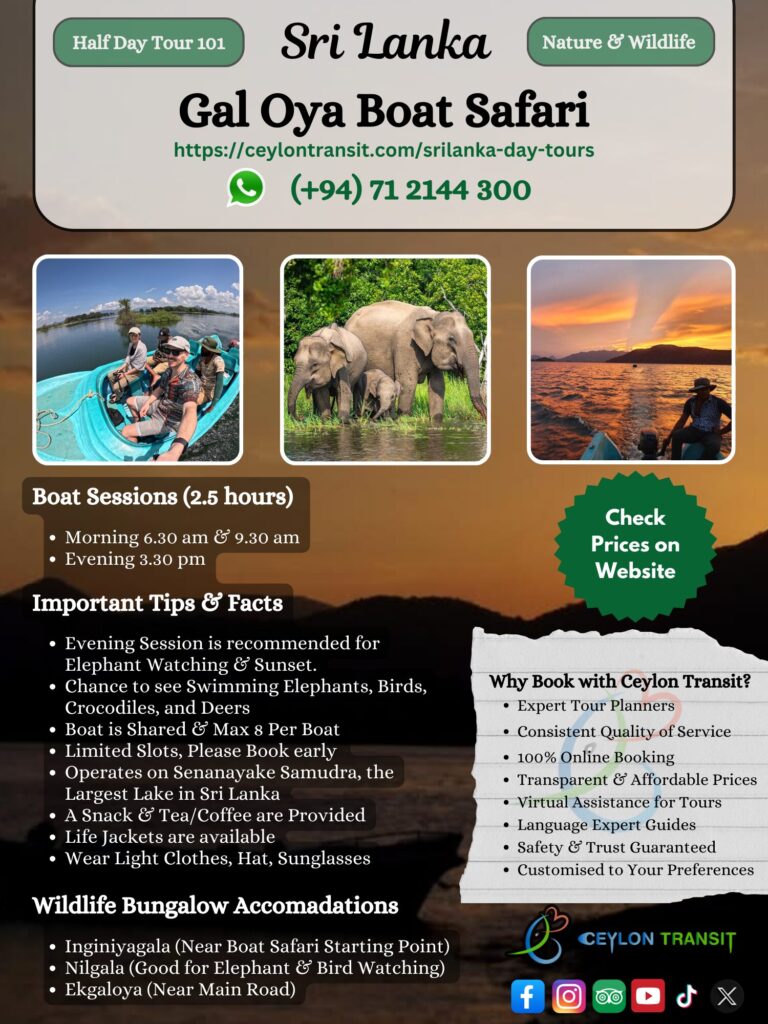

Gal Oya National Park, established in 1954, is one of Sri Lanka’s most tranquil and untouched protected areas, located in the Ampara District of the Eastern Province. The park is centered around the Senanayake Samudraya, the largest reservoir in Sri Lanka, making Gal Oya the only national park in the country where you can enjoy boat safaris that offer close wildlife encounters—especially with elephants that famously swim between islands in the reservoir.
The best time for a safari in Gal Oya National Park is during the dry season from May to September, when wildlife gathers around the shrinking water sources of the Senanayake Samudraya reservoir. This period offers the highest chance of witnessing the park’s iconic sight—elephants swimming between islands—as lower water levels encourage them to move across the lake. Jeep safaris are most rewarding in the early morning (6–9 AM) and late afternoon (3–6 PM), when temperatures are cooler and animals are more active. While the park is open year-round, wildlife visibility decreases during the November to January monsoon, when rising water levels reduce chances of seeing swimming elephants.

The main and most commonly used access point to Gal Oya National Park is the Inginiyagala Entrance, located near the Senanayake Samudraya dam. This entrance serves as the primary gateway for both jeep safaris and boat safaris, as the reservoir and forest tracks are easily reached from here. Visitors typically travel through Inginiyagala town, where the Department of Wildlife Conservation office and boat safari facilities are based. Due to the park’s remote and uncrowded nature, Inginiyagala is essentially the only official and practical entrance for public access into Gal Oya National Park.
| Bungalow Name | Location |
|---|---|
| Ekgal Oya Bungalow | Inside Gal Oya National Park |
| Inginiyagala Bungalow | Near Inginiyagala Entrance / Senanayake Samudraya |
| Nilgala Bungalow | Nilgala Forest / Bibile area |
Gal Oya National Park is unique among Sri Lanka’s national parks due to its vast reservoir, Senanayake Samudraya, which allows boat safaris—a feature unavailable in most other parks. Unlike Yala or Udawalawe, which are popular for high-density wildlife viewing (especially leopards in Yala and elephants in Udawalawe), Gal Oya offers a more peaceful, uncrowded experience, with a chance to see elephants swimming between islands, a spectacle unique in the country. Its lowland dry-evergreen forests and grasslands differ from Horton Plains’ montane grasslands or Wilpattu’s unique “Willus” (natural lakes). Birdlife is also richer than in some other parks, making it a prime destination for birdwatchers. In terms of accessibility, Gal Oya is less developed and more remote than Yala or Udawalawe, meaning fewer facilities and wildlife bungalows, but it compensates with tranquility and a close-to-nature safari experience. Overall, it is ideal for visitors seeking authentic wilderness, boat-based wildlife viewing, and off-the-beaten-path exploration.
Ceylon Transit
Typically replies within minutes
Hello! How can we help you?
WhatsApp Us
🟢 Online | Privacy policy